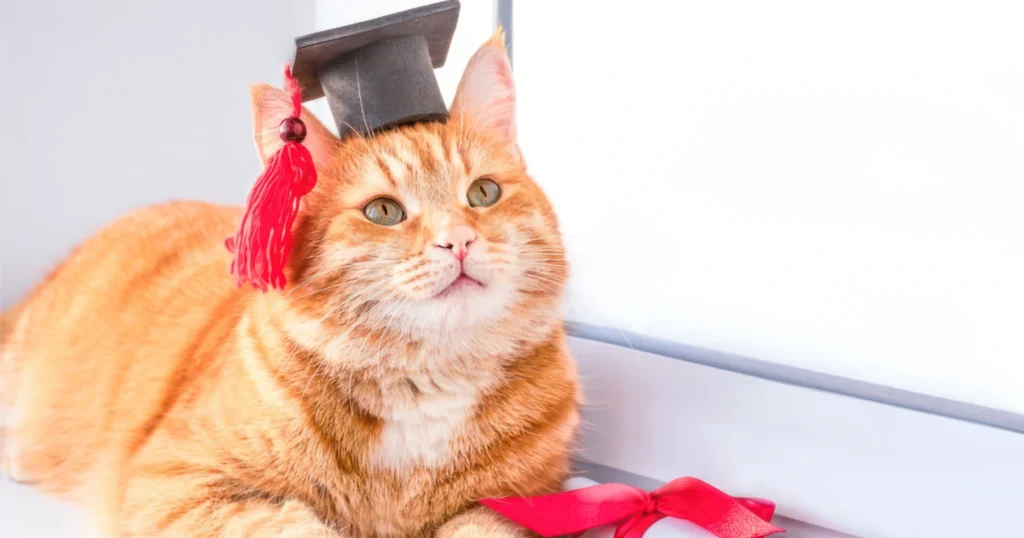The feline world is rife with mystery and intrigue. But guess what? Learning how to train a cat is a skill that can deepen your bond with your furry friend, improve their safety, and enhance household harmony.
Why Train Your Cat
Training your cat isn’t about turning them into circus performers, but more about developing a meaningful language that both of you can understand. It helps ensure they’re safe and contented. Whether it’s to stop the occasional curtain-climbing escapade or to master the perfect high-five, cat training can provide mental stimulation, reduce behavior problems, and even save their life in a risky situation. It can also simplify common household tasks, such as visits to the vet or groomer. Essentially, cat training opens up a line of communication between you and your pet, fostering a strong, respectful relationship built on mutual understanding and trust.
Common Myths About Cat Training
Cat training is surrounded by misconceptions. The most common myth? Cats are untrainable. Cats, in fact, can be just as responsive as dogs when it comes to training. Their independent nature often gets misconstrued as indifference or disobedience, but the reality is cats respond differently to training methods compared to dogs.
Another myth is that training cats requires punishment. Truth is, cats don’t respond well to punishment; they become scared and stressed, which can even exacerbate unwanted behaviors. Instead, positive reinforcement methods are proven to be much more effective and humane.
Finally, there’s the belief that cats will naturally behave if they’re loved and cared for. While a supportive environment is crucial, certain behaviors like scratching furniture or using a litter box do not come instinctively to cats and may require a bit of coaching. Remember, dispelling these myths is the first step to successful cat training.
Understanding Your Cat’s Behavior

Cats, with their alluring charm and independent spirit, often behave in ways that may seem elusive. Understanding the basics of feline behavior, the role of instincts, and how training can influence their actions is fundamental when learning how to train a cat.
Basics of Feline Behavior
At the heart of it, your cat is an explorer, driven by curiosity. Their seemingly quirky actions like chasing their tail, or their obsession with boxes, are part of their natural hunting and sheltering instincts. They have unique ways of communicating too – a slow blink is a cat’s way of saying, “I trust you.”
The Role of Instinct in Cat Behavior
Instinct plays a major role in a cat’s behavior. From their characteristic pounce to their tendency to cover their waste, many feline actions are instinctive and linked to their survival. Understanding this can help you channel their instinctive behaviors positively.
How Training Can Influence Behavior
Training, when done right, can significantly influence your cat’s behavior. It doesn’t mean suppressing their instincts, but rather guiding them towards safe and acceptable outlets. For example, instead of discouraging your cat from scratching—an instinctive marking behavior—you can provide them with a scratch post. Training helps in minimizing destructive behaviors, encouraging good habits, and strengthening your bond with your feline companion.
How Cats Learn: The Science Behind the Training
Cats learn through a process called “associative learning”—they associate actions with consequences. The principle of cause and effect. They quickly figure out that sitting politely might earn them a treat, while jumping on the counter gets them a stern “no.” This principle is key when training your cat. Consistent positive reinforcement for desired behaviors and gentle dissuasion for unwanted ones will help your kitty understand what’s expected of them, paving the way for effective training.
Decoding cat behavior and understanding their learning process is a journey of patience and observation. But remember, the rewards of having a well-trained cat who respects their boundaries while still being their adorable, playful self, are well worth the effort.
Basics of Cat Training

Cats, unlike dogs, aren’t generally known for their willingness to comply with human commands. However, understanding the training process, and applying patience, consistency, and positive reinforcement, can help you train your cat effectively.
Understanding the Training Process
In figuring out how to train a cat, remember that it’s not about control or mastery—it’s about cooperation and communication. It involves observing your cat, understanding their motivations and reactions, and using this knowledge to guide them towards desired behaviors.
The Importance of Patience and Consistency
Patience and consistency are key in cat training. Cats are independent creatures, and their training might require a longer time compared to dogs. It’s crucial to keep patient and not rush the process. Additionally, consistency is vital—mixed signals can confuse your cat. If you discourage them from scratching the sofa one day and ignore it the next, your cat won’t understand the rule.
Principle of Positive Reinforcement
Positive reinforcement is the most effective training technique for cats. Reward your cat immediately after they perform the desired behavior. This could be a treat, verbal praise, or a petting session—whatever your cat loves most. Over time, your cat will associate the positive consequence (the reward) with their action, encouraging them to repeat it.
Drawbacks of Using a Spray Bottle as a Deterrent
While it might be tempting to use a spray bottle as a quick fix to stop unwanted behavior, it’s not the best method. Your cat might start associating the unpleasant experience with you, leading to fear or aggression. Moreover, they may continue the behavior when you’re not around. Instead of punishment, focus on encouraging good behavior with rewards and providing appropriate outlets for their natural instincts.
Cat training doesn’t have to be a power struggle—it’s about building a mutual understanding and respect. With patience, consistency, and positive reinforcement, you’ll be able to guide your cat towards better behavior and enjoy a harmonious coexistence.
Essential Cat Training Topics

Let’s crack on with the essential tips on how to train a cat in various contexts.
Litter Training
A key aspect of cohabitating harmoniously with your feline friend is litter training. And here’s the thing: cats are naturally inclined to bury their waste, so it’s not as tricky as you might think.
Start by choosing a quiet, low-traffic area for the litter box and ensure the box is easily accessible. Cats are private critters, so they appreciate their ‘business’ area being out of sight. Make sure the box is large enough for your cat to comfortably move around in.
Introduce your cat to the box by placing them inside gently and scratching their paws in the litter to simulate digging. Do this several times during the day, especially after meals and naps. Remember to clean the box daily, as a dirty box can deter your cat from using it.
Marking Training
Oh, the woes of cat marking! This natural, instinctual behavior can be a real head-scratcher for cat parents. But don’t lose heart; it can be managed.
First off, get your cat neutered or spayed—if they’re not already—as this can significantly reduce marking behaviors. Next, provide enough resources—like litter boxes and scratch posts—to minimize territorial disputes in multi-cat homes.
If your cat still insists on leaving their signature scent everywhere, it’s time to do some detective work. Marking can often be a sign of stress or medical issues. Once you’ve ruled out health concerns with your vet, look around for potential stress triggers—like changes in your home environment—and address them.
Unwanted Behavior Training
Unruly behaviors like scratching furniture or counter surfing can leave you pulling your hair out. But hey, there’s hope!
Preventing undesirable behaviors begins with understanding your cat’s needs. Provide ample scratching posts for your cat’s scratching needs and ensure they’re tall, sturdy, and covered in a material your cat enjoys.
As for the counter surfers, try making the counters less appealing by removing food and other enticing items. Provide vertical spaces—like cat towers—for your cat to fulfill their need to survey their domain from a height.
Now, onto aggression. It’s crucial to understand that aggressive behavior often stems from fear, stress, or medical issues. If your cat suddenly starts showing aggressive behavior, a vet check-up should be your first step. Once you’ve ruled out health issues, consider seeking help from a cat behaviorist to identify the root of the problem and develop an appropriate solution.
Positive Reinforcement Training
Positive reinforcement training is a gold mine when it comes to teaching your cat desired behaviors. This involves rewarding your cat for desired behaviors, encouraging them to repeat these actions.
Treats are a fantastic tool for positive reinforcement training. You can use them to encourage your cat to use a scratching post, stay off the kitchen counter, or even come when called. But remember, it’s all about timing! The treat should be given immediately after the desired behavior, so your cat makes the right connection.
Teaching Your Cat to Come When Called
Wouldn’t it be wonderful if your cat could come running at the sound of your voice? It’s not as far-fetched as it sounds.
To train your cat to come when called, begin by choosing a command—like their name or a unique sound—and use it consistently. Start training in a quiet environment with minimal distractions. Call your cat using the chosen command, and when they come, reward them with a treat or a petting session.
Repeat this process several times a day, gradually increasing the distance between you and your cat, and introducing mild distractions. With patience and consistency, your cat will soon associate your call with positive experiences and respond accordingly.
Learning how to train a cat can be a journey filled with fun, frustration, and ultimately, fulfillment. So, let’s embrace the process, celebrate the victories, and remember—the goal is not a perfectly trained cat, but a happy, well-adjusted one.
Advanced Cat Training Techniques

Ready to take your cat training to the next level? Let’s explore some advanced techniques on how to train a cat, focusing on clicker training, and the use of hand signals and voice cues.
Clicker Training
Benefits of Clicker Training
Clicker training, borrowed from dog training, is a brilliant method to shape your cat’s behavior. This technique revolves around a small handheld device that produces a ‘click’ sound. Cats are keen on instant gratification, and the clicker provides immediate feedback, telling them they’ve done something right.
The benefits of clicker training are extensive. It’s a humane and effective way to teach new behaviors or refine existing ones. Clicker training also strengthens the bond between you and your feline friend and adds a dash of mental stimulation to their day.
Step-by-Step Guide to Clicker Training
To start clicker training, you first need to create an association between the clicker and something your cat likes, usually a tasty treat. This process, known as “charging the clicker,” involves clicking the device and immediately giving your cat a reward. Do this a few times until your cat reacts to the clicker’s sound, anticipating a treat.
The next step is teaching a behavior. Let’s take ‘sit’ as an example. Wait until your cat naturally sits, then click and treat. They will soon connect the action of sitting with the sound and the reward.
Gradually, you can add a cue, such as a word or gesture, before the action. Say ‘sit,’ then wait for them to sit, click when they do, and then reward. Be patient and consistent—soon, your cat will be responding to your cues like a pro!
Benefits and Techniques of Using Hand Signals
In addition to verbal cues, hand signals can be a powerful tool in training your cat. They tap into your cat’s keen observational skills and can even come in handy if your cat has hearing issues.
When introducing hand signals, start with a simple one. For instance, if you’re teaching your cat to sit, you might use a flat hand moving downwards as a signal. Consistency is key—use the same signal every time for the same command.
How to Use Voice Cues Effectively
Voice cues can be equally effective when training your cat. Remember, cats respond better to high-pitched, friendly voices. Use a clear, distinct word for each action, and say it just before or as your cat performs the desired behavior. Then, reinforce this with a treat.
Also, consider your cat’s name as a universal attention-getting cue. By consistently rewarding your cat’s attention when you say their name, you’ll teach them to tune into you whenever they hear it.
With these advanced techniques, you’re well on your way to mastering the art of cat training. Remember, every cat is unique, so keep an open mind and adjust your approach as needed. With patience, understanding, and a sprinkle of creativity, you’ll build an even stronger bond with your feline companion. Happy training!
Tips for Successful Cat Training

Ready to roll up your sleeves and dive into the rewarding world of feline training? Here are a few nifty tips to guide you on how to train a cat successfully.
Finding the Right Time for Training Sessions
Timing is everything! Cats, being creatures of habit, are most receptive to learning during their regular playtimes. Generally, a well-rested, mildly hungry cat is in the prime mood for a training session. Try to catch your kitty right before mealtime, when they’re eager and responsive to the promise of food rewards.
Keeping Sessions Brief and Focused
Next up, remember the golden rule: Less is more. Cats have notoriously short attention spans, so it’s essential to keep the training sessions brief—think 5 to 15 minutes at a stretch. Focus on one action or behavior during each session, and quit while you’re ahead, ideally while your cat is still interested and engaged.
Minimizing Distractions
Just like us, cats find it challenging to concentrate amidst chaos. So, find a quiet, familiar spot for training where your kitty won’t be sidetracked by the lure of chasing shadows or the sudden pounce of the neighbor’s cat. Your goal is to have your cat’s full attention on you and the task at hand.
Consistency with Cues and Signals
Consistency is key in training. Whether you’re using clicker training, voice cues, or hand signals, be consistent in your approach. Your cat will appreciate the predictability, and you’ll be amazed at how quickly they pick up the cues.
Training One Skill at a Time
Finally, avoid the common pitfall of trying to teach too many tricks at once. Stick to one behavior or command at a time. It might be tempting to rush the process, but remember, Rome wasn’t built in a day, and your cat won’t become a circus star overnight either. Patience and persistence are your best allies in this journey.
Incorporating these simple yet effective tips into your training regimen will make the process smoother, more enjoyable, and ultimately more successful. After all, learning how to train a cat isn’t just about teaching them new tricks—it’s about understanding their world and strengthening the bond you share. So, take a deep breath, arm yourself with a bag of treats, and embark on this exciting adventure. Trust us, the rewards are well worth it!
Troubleshooting Common Cat Training Issues

Every rose has its thorn, and in the garden of cat training, even the most seasoned green thumb might occasionally run into some prickly problems. Here, we tackle two common issues you might encounter on your journey on how to train a cat—dealing with stubborn felines and helping anxious kitties.
Dealing with Stubborn Cats
Oh boy, a stubborn cat can feel like trying to herd… well, cats. Here’s the scoop: stubbornness in cats often stems from a lack of motivation or the presence of a more appealing alternative. Therefore, your secret weapon is—drumroll please—rewards! Find a treat, toy, or activity that tickles your kitty’s fancy, and make it exclusive to training sessions.
But what if your feline furball is ignoring your carefully selected, top-of-the-range, gourmet treats? Time to change your strategy. Experiment with different types of rewards until you strike gold. Maybe Fluffy is a fan of feathery toys or maybe a chin scratch is their idea of heaven. Every cat is unique, and so are their motivators. Remember, persistence is the name of the game.
When Your Cat Is Scared or Anxious During Training
Nothing tugs at a cat parent’s heartstrings like seeing their fur baby scared or anxious. But hang in there, we’ve got your back. First up, identify what’s causing the fear. Is it a new environment? A loud noise? An unfamiliar face? Once you’ve identified the trigger, you can work on reducing its impact or removing it altogether.
Next, consider using calming aids. A feline pheromone diffuser or a calming collar can work wonders in making your cat feel more at ease.
One of the most important aspects of training an anxious cat is to create a positive association with the training process. Use rewards generously and make each training session feel like a fun game rather than a demanding task. The end goal should be to have your cat associate training with positive experiences.
Finally, be patient. Anxious cats might take a little longer to open up to training. But with love, patience, and understanding, they’ll get there. And when they do, the sense of accomplishment and the bond you’ll share will be worth every moment.
So, there you have it—a few tricks up your sleeve to help you navigate the bumpy road of cat training. Whether you’re dealing with a stubborn mouser or an anxious climber, remember that the journey of how to train a cat is filled with learning, bonding, and a whole lot of love.
Conclusion
There you have it, folks! You’ve just taken a deep dive into the catnip-infused world of feline training, unraveled the mysteries, and hopefully gleaned some nuggets of wisdom on how to train a cat. But as our feline friends might remind us—with a leisurely stretch and a disdainful look—it’s not just about getting them to obey commands. It’s about building a loving, understanding, and respectful relationship with our little furballs.
Cat training, while filled with its fair share of “hiss-terical” moments and mild frustrations, is undeniably rewarding. It doesn’t just make cohabiting easier by addressing undesirable behaviors, it also contributes significantly to your cat’s mental and physical wellbeing. In essence, it’s a labor of love, with dividends paid in purrs, headbutts, and affectionate nuzzles.
Ah, but one does not simply walk into the land of cat training without the trifecta of success: patience, consistency, and positive reinforcement. Patience is the silent whisper that encourages you to keep going when your cat turns up their nose at the umpteenth treat. Consistency is the steady rhythm that sets the pace for each training session, ensuring your cat knows what to expect. And positive reinforcement? That’s the secret sauce, the magic ingredient, the pixie dust that makes learning not just possible, but exciting and enjoyable for your cat.
In the end, the journey of how to train a cat is more than just a means to an end—it’s an enriching, rewarding adventure that deepens the bond between you and your feline friend. And isn’t that what it’s all about? After all, in the eloquent words of Roger Caras, “Cats are not just little dogs. They are another order of being.” So here’s to understanding and celebrating that order—happy training!


